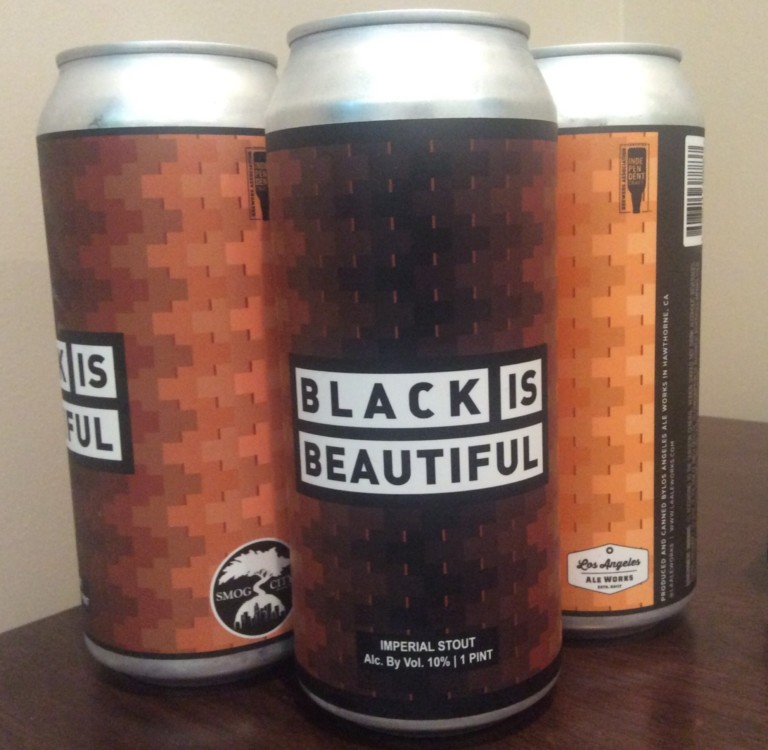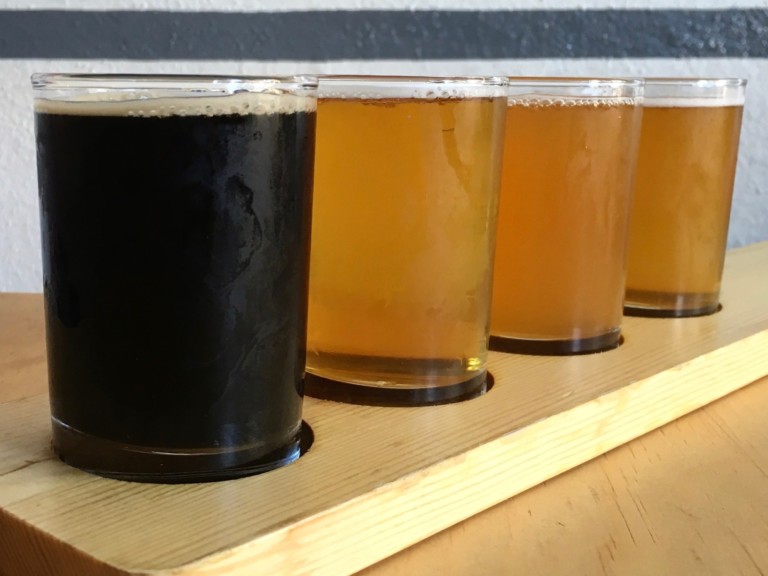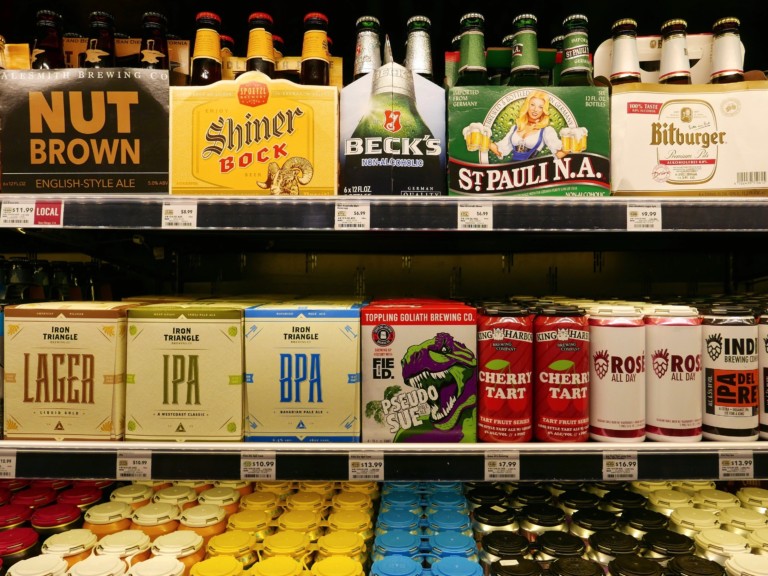Greene King brewmaster John Bexon was recently in the U.S. for a promotional tour, touting beers from his employer’s 210-year-old family of pubs and breweries. During his brief L.A. stay, we met at 1739 Public House in Los Feliz, where he discussed his background and approach before providing insights about Greene King’s line-up, one bottle and can at a time.
Tell me about Old Speckled Hen.
It’s 5.2%, and unlike most of the beers here, it’s not late hopped. What it does have is a big proportion of crystal malt, and if I had some crystal malt here to chew, you would find a very nice toasted flavor from it. It manifests itself in the final product as a caramel, toffee flavor. There are hops in here, so there’s a background layer of bitterness, but most of the aroma is coming from the malt itself.
What I always say to people is, take a sip of beer, then take another sip, and this time, slurp it so you can pull it across your tongue. It hits the bitterness receptors, which are at the back. What you get is a bigger finish and much more intense flavor. You need to get the air inside at the same time. You see tea tasters do it, and wine tasters. It’s about hitting the back of the throat, and the back of the tongue. It doesn’t matter if you dribble. You get a much bigger finish. As it goes down, you spread it over your tongue. The tip is where you taste sweet, and as you come up along the sides you taste salt. Then there’s a big chunk in the center where you taste sour. Sour stimulates saliva, which stimulates hunger. The link between beer and food has been there for a long time. When you’ve had a few beers, you need a kebab or something at the end of it. Right at the back, you get at those bitterness receptors, and most people miss those. It’s good to get into that habit of tasting beers like that.
In your nose, you’ve got 42 aroma receptors, so getting the smell from swirling it, you get the volatiles. You get a lot of aroma from the volatiles in the beer from fermentation, but also from aromatic oils in the hops. In this particular beer, you don’t get a lot of aroma because it’s all from the roasted malt, but if we were to try this one, which is the export IPA, there’s a late hop in there. That gives you very much a grassy, herbal note, which is from a variety called target. Abbot Ale has a late hop called Fuggles in it, which gives you a spicy, peppery character.
What would you suggest pairing with Old Speckled Hen, food wise?
Pairing food with beer is very subjective. What you like, what I like…I actually just came from a beer tasting, and we paired a stew, a big stew made with Abbot Ale, not Old Speckled Hen, so it was quite a rich gravy in the stew. It’s about comparing and contrasting. If you had a chile beer, you wouldn’t eat it with a chile.
How did that work for you? Were you happy with the result?
Yeah, it was good, and that’s because at 5.2%, it’s strong enough to cut through the grease and fatty content. There you’ve got a contrasting flavor. We tried this one later (points to Olde Suffolk), a sweet beer, which went with the bread and butter pudding. You’ve got a sweet bread and butter pudding with a sweet beer.
How would you describe Tanner’s Jack?
4%. It’s a pale ale. It is quite more-ish, quite sessionable at 4%. It is quite spicy on the nose. It has a malt in it called Amber Malt. If you chew it – all these beers have a white malt – and the one involved in the pale ale this year is made from a barley called Tipple. Tipple is a variety of barley that is a spring barley, a two-row barley. It’s a relatively new variety. It’s only been around for three or four years. A lot of brewers in the U.K. have embraced it. It’s very high yielding for the farmer, so the farmer gets a good return. It’s quite an easy variety to malt. Spring barley gets a slightly higher extract for its pound (or its dollar), which means it’s a win, win, win. If you were to chew that white malt, its sweetness would be akin to muesli, very sweet. If you chew the Amber Malt, which is about 10% of it, it’s almost like a digestive biscuit. It’s an earthier taste, a little bit of bite, a little bit of more-ishness.
What’s a good food to have with it?
It’s 4%, so it’s not particularly alcoholic. As a refreshing drink, it might complement spicy dishes like chili, maybe a curry.
Tell me about the Wexford Irish Cream Ale.
Well, the Wexford of course is a widget. You can hear it clanking around inside, so that becomes clean flow. The introduction of nitrogen into beer changes the perception and changes the mouth feel. Also, it changes the perception of things like bitterness. The analytical bitterness is still high on the palate. Bitterness on the aroma and back of your tongue are masked a little bit by the nitrogen. That said, the style, because it’s a smooth flow, it’s easy to drink because of the mouth feel.
What would you eat with that?
With smooth beers, maybe pasta. I’m not really an expert on smooth beers, but certainly pastas. Because it’s not too bitter, anything that’s got a kick in it, like chile dressing or maybe tossed salad with chilies in it. Maybe even some olive oil.
The Olde Suffolk?
This is actually an amazing beer, because it’s two different beers in here. It’s a blend of two beers. One component is an oak-aged 12% old ale, and the rest of it is a 6% strong ale, but it’s fresh. A two-year-old beer sits in the oak vessels for a minimum of two years, and the microflora in there slowly matures the flavor and it almost sours it like a Belgian Lambic beer. 12% alcohol is like a sour cherry, still nice in its own right, but a little bit overpowering, so with the sweet fresh beer, 6%, probably in a ratio of 90 to 10, it just softens and takes the edge off the 12% and gives a nice rounded, full, sweetness. It’s also got molasses in it, which gives it a treacle character. You get a lot of mouth feel, quite sweet, complements sweet puddings.
So the molasses helps with viscosity?
No, this is actually fermented, but it helps give you a sweet treacle flavor. It’s not intense, but it’s there in the background, and it probably complements a little bit the sourness of a 12%. And I would pair that with syrup fruits, bread and butter pudding.
So desserts?
Desserts, but it would probably go equally well with a strong cheese, maybe a blue cheese.
And the IPA?
This is an export IPA. There’s a lot of stories on IPAs. The Greene King IPAs that we produce normally at the breweries is 3.6%, which you’d call the cask version. This is 5%, which we call the export IPA. At 5%, this is stronger and some of the flavors change. With this, you get a very grassy, herbal nose to it, and that’s due to a late hop, the target hop. You get a lot of aroma with this.
The export goes very well with fish dishes, things like shrimp.
Richer fish, like bass or salmon?
Yeah, anything like that. You’ve got the balance between a clean tasting fish and a zesty beer.
Export, does that mean its not available in the U.K.?
It is available in the U.K., but only in bottles.
What about Hen’s Tooth?
That’s an interesting one. It’s a stronger variant of this, the Old Speckled Hen. As you can see, it’s bottle conditioned, so you can see the yeast. In storage, so there isn’t too much yeast or sugar, or too much gas in the bottle, it will explode, so it’s quite key to get the right balance. A little bit of secondary conditioning in the bottle because the beer sits on the yeast, the yeast cells explode over a period of time. You get a little bit of the flavor of the yeast, which makes it quite bitter. Yeast has got a lot of hop compounds.
So it’s the most bitter beer?
No, it’s not the most bitter, but it’s got the perception of being quite bitter. The most bitter beer that we do is Ruddles County, which you can’t get over here in the States. Again, if you were to slurp it, draw the Ruddles over the back of your tongue, you’d get a much longer, intense finish. It’s drier, almost like a metallic because it’s bitter, as a result of the hopping part.
What would you pair the Hen’s Tooth with?
At 6.5%, it’s quite strong. I’d probably put it with cheese again, or on a personal level, I use it to make gravy. I put it into pies, and that is excellent with marinating meat. I probably cook with it more than I do pairing it, but again, subjective.
Finally, Abbot Ale.
That’s my favorite beer. 5%. It’s got a range of malts in there. It is unique in that it has a late hop, Fuggles gives it a very spicy nose to it, but also, it’s a slow fermentation for a strong beer. That’s to get a lot of fruit characters, not citrus fruit that you’d get with American hops like Willamette and Cascade, but it comes from the malt, it’s almost like a dried fruit, raisins, sultanas, fruit cake, if that makes sense. It’s fruit cake, with a spicy nose. I find it quite more-ish, but some people find it a little bit stronger. Again, I always call it mother’s milk.
What do you like to eat with it?
Well, beer and curry is me. I love my curries. I wouldn’t say it’s my staple diet, but a few Abbot Ales and then on to a curry house, fantastic.









Blog Comments
pharmacy technician
June 6, 2010 at 12:16 AM
Wow this is a great resource.. I’m enjoying it.. good article
World Travel Tours » Europe Travel Tours In Search Of Belgian Beers
May 28, 2010 at 2:14 PM
[…] Food GPS » Greene King Beer Tasting with brewmaster John Bexon […]
World Travel Tours » Europe Travel Tours In Search Of Belgian Beers
May 28, 2010 at 2:14 PM
[…] Food GPS » Greene King Beer Tasting with brewmaster John Bexon […]